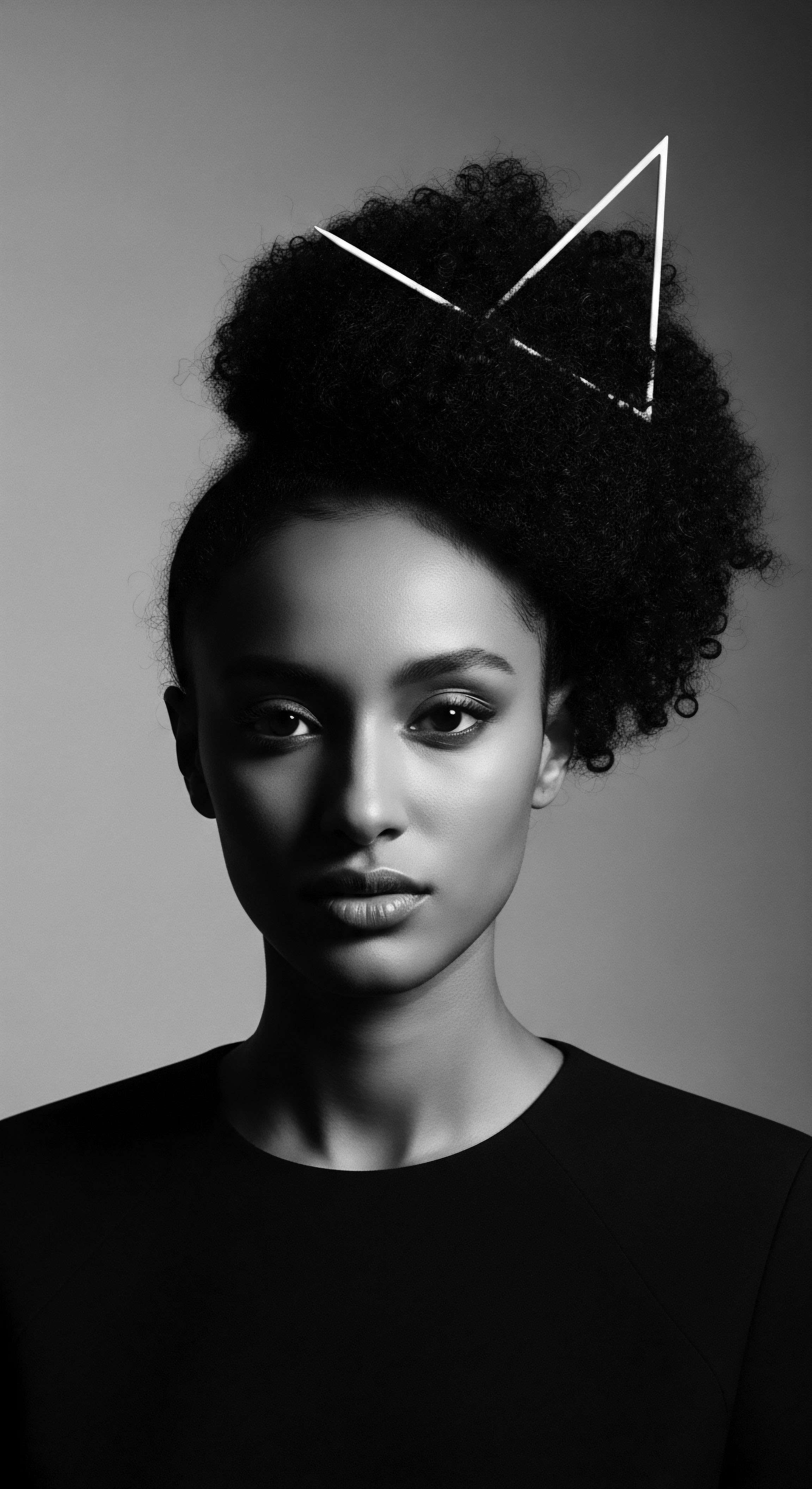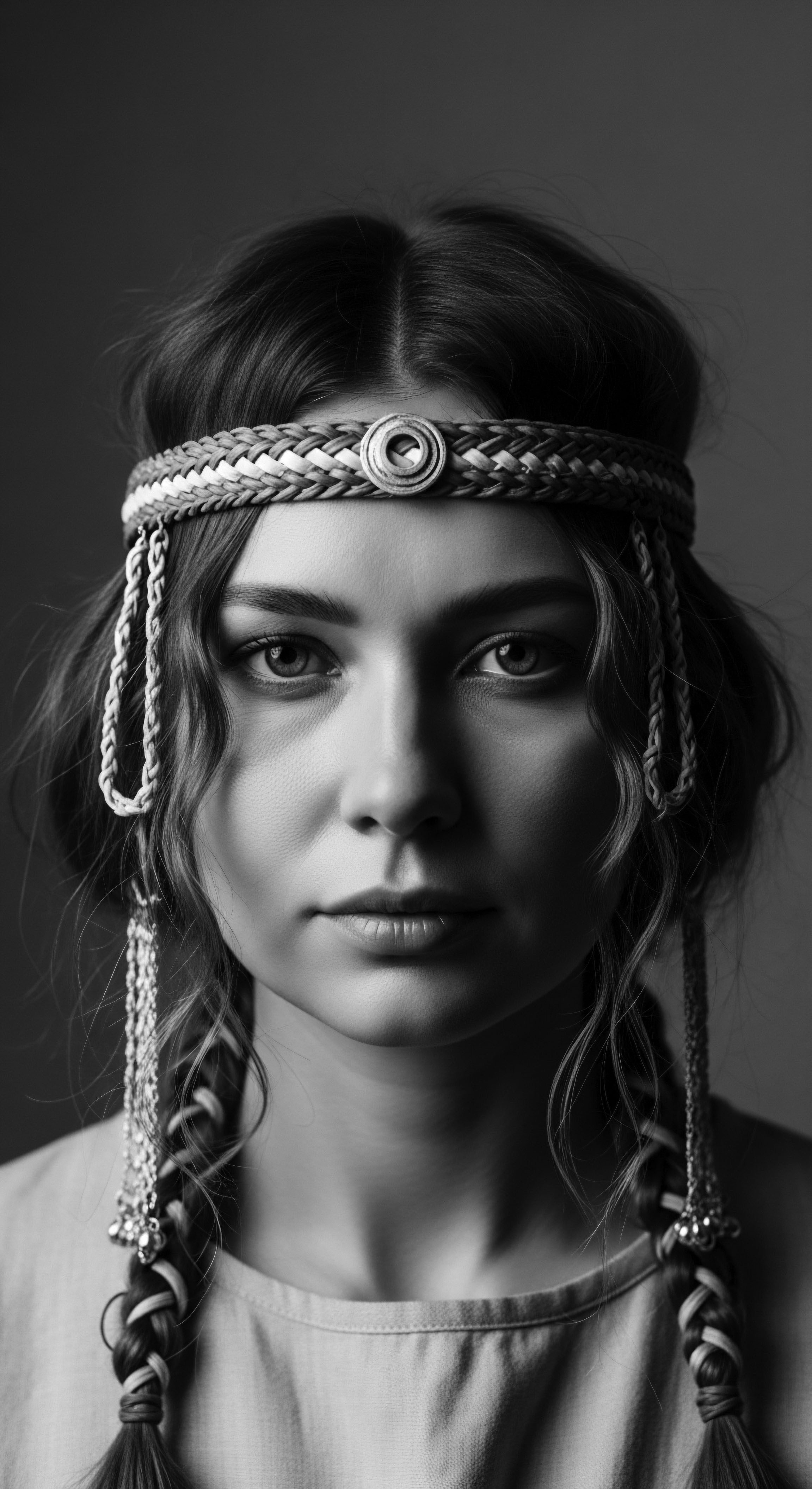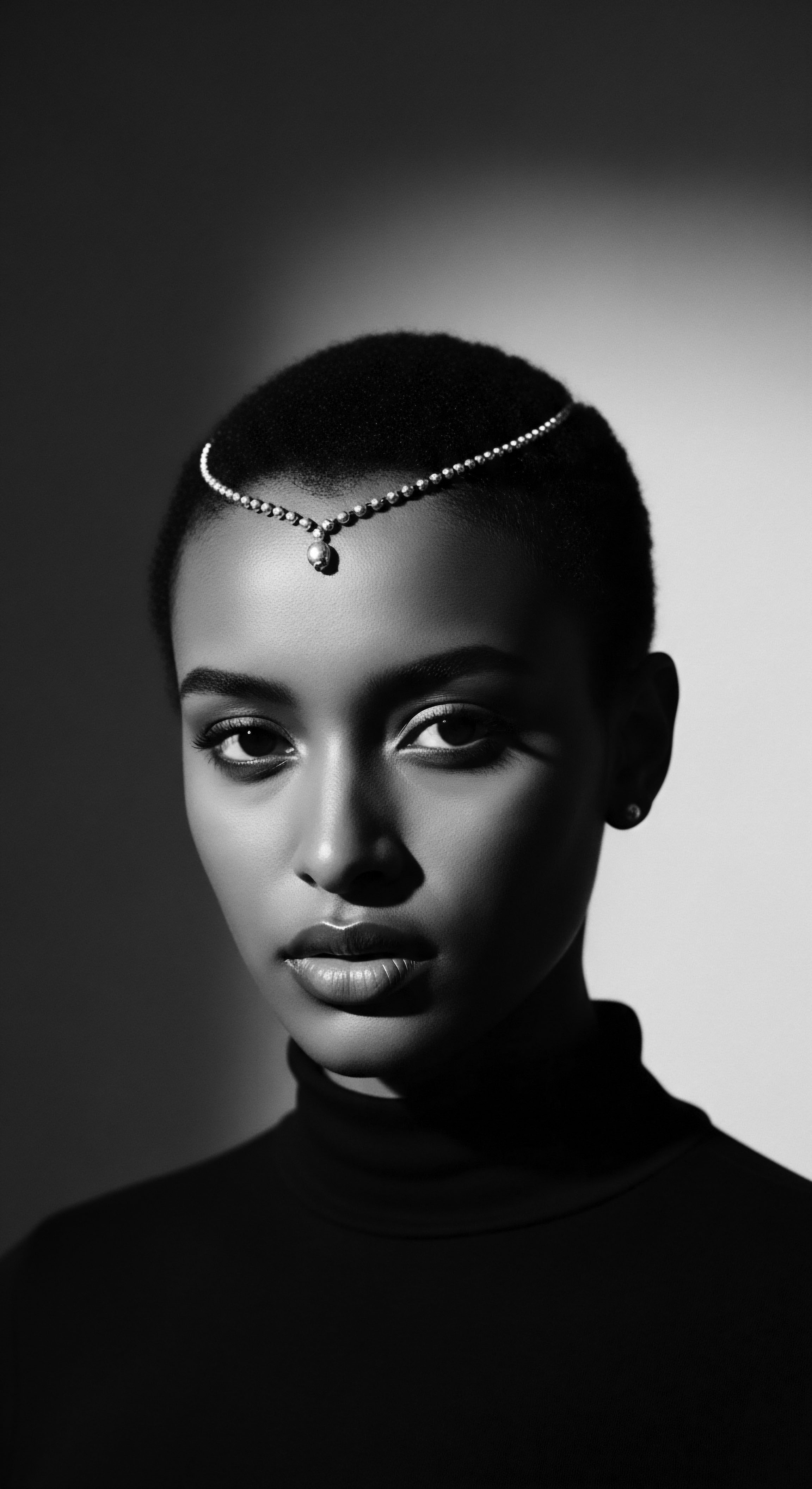
Roots
The sun’s fierce kiss, the wind’s relentless whisper, the unseen touch of dust-laden air—these elements have shaped the very existence of textured hair, influencing not just its outward appearance, but its inherent protective capacity for the scalp. We stand at a precipice where ancestral wisdom converges with modern science, offering a profound appreciation for this crown of resilience. It is not merely a question of whether textured hair shields the scalp, but how, through millennia of adaptation and the ingenious practices of Black and mixed-race communities, it has acted as a living, breathing barrier against the world’s environmental clamor.
From the ancient lands of Africa, where humanity first walked, the very architecture of textured hair evolved in close conversation with demanding climates. The tightly coiled helix, often misunderstood in its intricacy, was a natural response to the sun’s potent ultraviolet rays. This unique morphology created a dense canopy, a natural parasol, effectively minimizing direct solar exposure to the sensitive scalp beneath. Scientific inquiries reveal that the very structure of afro-textured hair, with its elliptical cross-section and characteristic curl, permits air circulation, which can also help with thermoregulation in hot environments.
Textured hair, a testament to ancient adaptation, offers intrinsic protection to the scalp through its unique structural design.

Hair Anatomy and Ancestral Wisdom
The anatomy of textured hair, from its follicular origin deep within the dermis to the outermost cuticle layers, speaks a language of protection. The hair follicle, curved in textured hair, produces a strand that grows in a tiny spring-like spiral, almost parallel to the scalp. This spring-like growth contributes to the hair’s collective volume and density, creating a natural shield.
The sebaceous glands, intimately associated with each hair follicle, secrete sebum, a lipid-rich substance that coats the hair shaft and scalp. Sebum acts as a natural moisturizer and protective film, safeguarding the skin from dehydration and environmental aggressors. While the distribution of sebum along the coiled strand can be a challenge for moisture reaching the ends, the presence of this natural oil at the scalp’s surface remains a significant line of defense. The internal lipids within the hair fiber also contribute to its integrity, hydrophobicity, and moisture retention, building a barrier against external factors.

Evolutionary Gifts of Hair and Scalp
The very concept of Scalp Integrity is deeply rooted in ancestral understanding. Before the advent of modern dermatological science, indigenous communities possessed a profound practical knowledge of maintaining scalp health. They observed how environmental factors like intense sun, dust, and wind could lead to dryness, irritation, and discomfort. Their haircare practices were, therefore, not merely about aesthetics, but about fortifying this natural defense system.
Consider the Denseness of Textured Coils. This inherent characteristic, though sometimes perceived as a challenge in Western beauty standards, is a biological marvel. It creates a physical barrier, diminishing the amount of direct sunlight reaching the scalp.
Studies suggest that the density of afro-textured hair, although fewer strands per square centimeter compared to straighter types, offers notable protection from the sun. This natural density acts as a living, breathing canopy, reducing exposure to ultraviolet radiation, a common environmental stressor.
| Aspect of Textured Hair Hair Morphology (Tightly Coiled Shape) |
| Protective Function from an Ancestral/Modern View Creates a dense physical barrier, reducing direct sun exposure to the scalp and allowing air circulation for thermoregulation. |
| Aspect of Textured Hair Sebum Production |
| Protective Function from an Ancestral/Modern View Forms a natural hydrolipidic film on the scalp, moisturizing and protecting against environmental aggressors, including dehydration and bacterial growth. |
| Aspect of Textured Hair Hair Density |
| Protective Function from an Ancestral/Modern View While less dense in strand count, the volume and collective mass of coiled strands provide a significant canopy, shielding the scalp. |
| Aspect of Textured Hair The intrinsic design of textured hair speaks volumes about its ancient protective purpose for the scalp against environmental elements. |

Ritual
The journey of hair care, particularly for textured strands, has always been intertwined with ritual – practices passed down through generations, each movement carrying the weight of communal memory and purpose. It is within these deep-seated traditions that the capacity of textured hair to shield the scalp from harsh environmental elements is truly amplified. Ancestral communities did not simply exist within their environments; they harmonized with them, often through practices that elevated hair care to a sacred art. These rituals, whether daily acts of anointing or elaborate communal stylings, actively contributed to the scalp’s well-being and defense.

Traditional Styling as Shielding Practice
Consider the profound role of Protective Styling. Long before the term entered contemporary hair lexicon, African societies had perfected the art of braiding, twisting, and locking hair not merely for adornment or social status, but as a practical solution to environmental challenges. These styles tucked away fragile ends, minimized manipulation, and, crucially, served as a physical barrier for the scalp against sun, dust, and wind. The resilience of hair in challenging climates was sustained through these ingenious methods.
- Cornrows ❉ Originating in Africa, these braids plaited close to the scalp, not only defined social identity but offered a seamless shield against the elements, particularly the intense sun and wind experienced in many regions.
- Fulani Braids ❉ Rooted deeply in West African culture, these intricate patterns often adorned with beads and shells, were more than aesthetically compelling. They provided comprehensive protection for the scalp and hair, guarding against environmental damage.
- Bantu Knots ❉ While celebrated today for their modern appeal, these coiled sections of hair secured close to the scalp served a protective function, keeping hair contained and the scalp guarded.
The application of natural oils and butters was a consistent thread running through these traditions. In many African tribes, Shea Butter was used to moisturize and protect hair from harsh environmental conditions, applied to leave hair soft and manageable. The Himba tribe of Namibia, for instance, famously uses a mixture of red ochre and butterfat, called Otjize, which serves as a cultural symbol and a practical protectant against the sun and insects. Such practices illustrate a deep understanding of natural emollients as barriers.
Ancestral care practices, especially protective styles and natural ingredient application, provided intentional safeguarding for the scalp.

Can Ancestral Methods Inform Modern Scalp Protection?
The answer is a resounding yes. The wisdom passed down through generations provides a blueprint. For instance, the use of headwraps, or ‘Dukus’ in Ghana, ‘Geles’ in Nigeria, and ‘Doeks’ in South Africa, served as powerful cultural markers and practical tools for scalp protection. Historically, headwraps shielded wearers from the sun’s harsh rays, dust, and wind in arid climates.
Even today, many women wear headwraps as a protective headgear while sleeping to prevent dryness from cotton pillowcases. This continuity speaks to their enduring efficacy.
The significance of these practices extends beyond mere physical defense. They speak to a holistic approach to well-being where hair, identity, and environmental harmony were inseparable. The systematic use of natural ingredients like aloe vera, yucca root, and various indigenous oils for cleansing, conditioning, and scalp treatments across indigenous cultures globally highlights a collective wisdom in leveraging nature’s bounty for hair health.

The Enduring Legacy of Scalp Care Practices
The practice of Hair Oiling, central to many indigenous hair care traditions, offers substantial protection. Oils infused with local herbs were meticulously applied to nourish hair from roots to ends, imparting strength, shine, and moisture. This practice also directly addressed scalp health, promoting blood circulation and maintaining a healthy environment for hair growth. The very act of massaging oils into the scalp would have stimulated circulation, promoting nutrient delivery to the hair follicles and supporting the skin’s barrier function.
These methods were not arbitrary. They were a carefully cultivated body of knowledge, refined over centuries, attuned to the specific needs of textured hair in diverse environmental contexts. The insights gained from these ancestral practices offer a valuable perspective on how to foster scalp resilience in the modern world, encouraging a return to gentler, more natural approaches that honor the inherent capabilities of textured hair.

Relay
To delve deeper into the question of textured hair’s protective capacity, we must consider the sophisticated interplay of its biological attributes with the historical adaptive strategies developed by Black and mixed-race communities. This is not simply about physical defense; it is about a cultural narrative of resilience, where hair became a site of survival and expression against environmental stressors, both natural and societal. The ancestral blueprint of hair care practices provides a rich framework for understanding how modern science validates and expands upon these timeless truths.

Microscopic Shields and Macroscopic Wisdom
The unique structure of textured hair strands—their elliptical cross-section and tightly coiled, sometimes flat, growth pattern—creates an inherent mechanical barrier. This structural characteristic means that less direct sunlight reaches the scalp compared to straight hair types, offering a degree of natural UV protection. The spirals themselves create a kind of microscopic meshwork, which can diffuse incident radiation and lessen direct impact on the scalp. This bio-physical attribute is complemented by the scalp’s own mechanisms.
The sebaceous glands, while providing essential lubrication, also produce a complex lipid mixture that forms the hydrolipidic film. This film acts as a protective barrier, reducing skin dehydration and possessing antibacterial and antioxidant properties due to components like vitamin E. While excessive sebum can lead to issues, its natural presence is a key component of the scalp’s defense.
Environmental pollution, specifically particulate matter (PM), can adhere to hair and infiltrate follicles, leading to scalp irritation and excessive sebum production. This highlights the need for effective cleansing and protective strategies, mirroring ancestral practices that prioritized clean, balanced scalps using natural washes.

How do Environmental Toxins Challenge Scalp Health?
The environmental stressors confronting textured hair and scalp extend beyond sun and wind to include pollutants and harsh chemicals. Air pollution can alter the hair surface and infiltrate follicles, potentially affecting hair growth and texture. Long-term exposure may contribute to scalp irritation, itching, and excessive sebum secretion.
Polycyclic Aromatic Hydrocarbons (PAHs), widespread organic pollutants, can damage the hair cuticle and protein. This presents a modern challenge that ancestral solutions, focused on natural ingredients and protective measures, can help address.
Historically, indigenous communities used a diverse array of plants and natural compounds to maintain hair and scalp health, addressing issues that align with modern concerns about environmental damage. For example, traditional African medicinal plants have been used to treat alopecia, dandruff, and various scalp infections, often through topical applications of oils, pastes, or infusions. This rich ethnobotanical knowledge offers a valuable perspective on natural defense mechanisms.

Ancestral Practices as a Data-Backed Shield
The concept of Protective Hairstyles, a cornerstone of textured hair heritage, stands as a prime example of both cultural ingenuity and scientific efficacy in safeguarding the scalp. These styles, which tuck away hair ends and minimize daily manipulation, directly reduce exposure to environmental elements like extreme temperatures, humidity, and precipitation. This physical shielding extends to the scalp, acting as a buffer against external aggressors.
A powerful historical example of this protective function is evident in the strategic use of hairstyles during the transatlantic slave trade. Enslaved African people, stripped of much of their cultural identity, continued to use intricate braided styles not only for their practical low-maintenance benefits during long workdays but also for their profound symbolic meaning. Some historical accounts even suggest that braids were used as maps to escape routes or to conceal seeds for survival, thereby integrating cultural resilience with practical protection in a hostile environment (Byrd & Tharps, 2001, p.
57). This speaks to the multi-layered utility of textured hair styling as a form of protection.
- Minimized Manipulation ❉ Protective styles reduce constant combing, brushing, and styling, which can cause breakage and expose the scalp to friction and stress.
- Physical Barrier ❉ Tucked-away hair, especially in dense braided or twisted forms, physically shields the scalp from direct sun, wind, and airborne particles.
- Moisture Retention ❉ By enclosing the hair, these styles help to seal in moisture, counteracting the drying effects of environmental exposure, particularly in dry climates.
This historical use of hair as a form of practical and symbolic resistance highlights the deep connection between textured hair, its cultural legacy, and its inherent protective capabilities. The emphasis on natural ingredients like shea butter and coconut oil in traditional African hair care, used to add moisture and strength, also directly counters the dehydrating effects of environmental exposure. These practices underline a sophisticated understanding of hair and scalp biology, long before the advent of modern laboratories.
Textured hair’s protective heritage is not merely a historical footnote; it is a living science, validating ancient wisdom with contemporary understanding.

Connecting Modern Science to Heritage Practices
The synergy between scientific understanding and ancestral knowledge offers potent insights into how textured hair defends the scalp. The natural hair movement of recent decades, encouraging acceptance of natural hair and a departure from damaging products, mirrors the ancestral embrace of hair’s inherent qualities. This movement has reignited interest in protective styles and natural ingredients, many of which are now being studied for their biochemical properties.
For instance, the antioxidant and anti-inflammatory properties of native botanicals used in traditional remedies, such as Silky Oil Grass (Native Silky Lemongrass) in Aboriginal bush medicine, are now being recognized for their ability to soothe scalp irritation and protect against environmental damage. This contemporary validation strengthens the argument for the protective power of textured hair, especially when supported by time-honored care rituals. The knowledge embedded within textured hair heritage offers a guiding light, reminding us that true scalp protection comes from honoring the hair’s natural design and the wisdom of those who understood it best.

Reflection
The journey through the intricate world of textured hair and its profound connection to scalp protection from environmental elements reveals a truth far richer than simple biology. It speaks to a heritage deeply etched in the very helix of each strand, a legacy of adaptation, resilience, and ingenuity born from centuries of living in harmony with the natural world, even as circumstances often forced disharmony. The Soul of a Strand, indeed, holds within it the echoes of countless hands that braided, oiled, and adorned, not just for beauty, but for survival.
This editorial exploration reinforces the notion that textured hair is inherently equipped with protective attributes, its unique architecture serving as a biological shield. More significantly, it illuminates how ancestral practices—from the strategic density of protective styles to the intuitive application of natural emollients and botanicals—transformed these natural endowments into an active, conscious defense system for the scalp. These traditions were not mere customs; they were sophisticated forms of health management, passed down through the living archives of family and community.
As we gaze upon a crown of textured hair today, we witness a living testament to an unbroken chain of wisdom. The question, “Can textured hair truly protect the scalp from harsh environmental elements?”, dissolves into a deeper understanding ❉ it always has, and it always will, guided by the whispers of the past and the enduring spirit of its heritage. This profound connection is a constant invitation to honor, learn from, and celebrate the magnificent protective essence woven into every coil and curl.

References
- Byrd, A. and Tharps, L. (2001). Hair Story ❉ Untangling the Roots of Black Hair in America. St. Martin’s Press.
- Gavazzoni, M. F. & de Abreu, L. S. F. (2017). Hair Protection from UV Radiation ❉ A Review. Skin Appendage Disorders, 3(4), 189-195.
- Ajao, A. A. & Sadgrove, N. J. (2024). Cosmetopoeia of African Plants in Hair Treatment and Care ❉ Topical Nutrition and the Antidiabetic Connection?. Diversity, 16(2), 96.
- Johnson, T. A. & Bankhead, T. (2014). Hair It Is ❉ Examining the Experiences of Black Women with Natural Hair. Open Journal of Social Sciences, 2(1), 1-13.
- NYSCC (2021). Impact of Environmental Stressors on Hair. Retrieved from NYSCC website.
- JD Institute of Fashion Technology (2021). HEADWRAPS ❉ HISTORY AND EVOLUTION.
- Yaye (2025). Shampoo & Conditioner with a Purpose – Indigenous Haircare for Healthy.
- Booksy.com (2021). How To Style Natural Hair – The Best Protective Hairstyles Out There.
- CRLab (n.d.). Hyperseborrhea.
- Doria Adoukè (2022). All you need to know about afro hair.
- Afrostreet (2025). The Cultural Significance of Headwraps & How to Wear Them ❉ Embracing Heritage and Style.
- Obé Headwear (2024). Significance of headwraps | Hair care.
- Sonsons (2021). The History of Headwraps and Black Culture.
- Rennora Beauty (2025). African vs African American Hair ❉ Is There a Difference in Texture?
